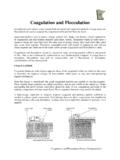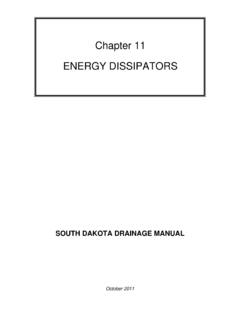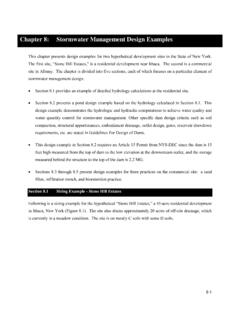Transcription of DETENTION POND - DESIGN GUIDE - Thurston County
1 DETENTION Pond DESIGN GUIDE Page 1 of 13 DESIGN GUIDE NO. 1 DETENTION POND DESIGN UNDER THE 2009 DRAINAGE DESIGN & EROSION CONTROL MANAUL T. Pat Allen, , Senior Engineer, Drainage Manual Thurston County Water Resources Division Resource Stewardship Department October 20, 2009 Purpose The purpose of this DESIGN GUIDE is to summarize in one location the requirements for designing DETENTION ponds using the 2009 Drainage DESIGN and Erosion Control Manual for Thurston County (DDECM). DETENTION pond DESIGN requirements are found in several locations within the DDECM including: Volume I, Section , Minimum Requirements Volume I, Section , Drainage and Erosion Control Plan Volume I, Chapter 4, Stormwater BMP Selection Process Volume III, Section , Minimum Computational Standards Volume V, Chapter 4, Section , , DETENTION Ponds.
2 Volume V, Appendix V-A, Structures -- Control structures Volume V, Appendix V-C, Maintenance Guidelines Volume V, Appendix V-D, Access Roads and Ramps Volume V, Appendix V-E, Site DESIGN Elements Requirements for fencing, signage, setbacks, easements & planting/landscaping. Hydrologic DESIGN Criteria Minimum Requirement No. 7, Flow Control, requires projects to reduce the impacts of stormwater runoff from impervious surfaces and land cover conversions. This includes controlling the discharge from a project site such that the stormwater discharge from a threshold discharge area shall match developed discharge durations to pre-developed discharge durations for the range of pre-developed discharge rates from 50% of the 2-year peak flow up to the full 50-year peak flow.
3 The purpose of the requirement is protect streams from stream bank erosion. The pre-developed condition to be matched shall be a forested land cover, unless reasonable historic information is available that indicates the site was prairie prior to settlement. A continuous simulation hydrologic model shall be used for designing DETENTION ponds. Generally this is the Western Washington Hydrologic Model, Version 3 (WWHM3) as developed for the Department of Ecology by Clear Creek Solutions, The WWHM3 has also been modified with Thurston County specific data and the modified version shall be used for DESIGN facilities in Thurston County .
4 A flow control facility ( DETENTION pond is one type of flow control facility) is required for projects that: 1. Create 10,000 square feet or more of effective impervious surfaces in a threshold discharge area. DETENTION Pond DESIGN GUIDE Page 2 of 13 2. Projects that convert of an acre of native vegetation to lawn or landscape or convert acres or more of native vegetation to pasture in a threshold discharge area and from which there is a surface discharge in a conveyance system (natural or man-made) from the site. 3. Projects that through a combination of effective impervious surfaces and converted pervious surfaces, causes a cubic feet per second increase in the 100-year recurrence interval flow frequency from a threshold discharge area.
5 A threshold discharge area is defined as an onsite area draining to a single natural discharge location or multiple discharge locations that combine within one-quarter mile downstream (as determined by the shortest flowpath). Effective impervious surfaces are those impervious surfaces connected via sheet flow or discrete conveyance to a drainage system. If runoff from an impervious surface is infiltrated or dispersed into native vegetation or amended soils in accordance with Dispersion BMPs described in Volume V of the DDECM the surface is considered ineffective.
6 Pond Aesthetics DETENTION ponds should be made an attractive feature of the urban environment. Aesthetic considerations should be incorporated into the DESIGN including: Curvilinear DESIGN (non rectangular) Landscape plantings above the water level of the pond. DESIGN to allow public use for recreation during dry season. Play area, volleyball court, etc. Incorporate the DETENTION pond into other on-site features such as walking trails, picnic area, etc. Consider combined DETENTION and wetland/wetpond to provide permanent pool volume to enhance year-round aesthetics.
7 Special Requirements If a DETENTION pond is located within the Well Head Protection Area of a public water system with over 1,000 connections a minimum of 3-feet of separation to the seasonal high groundwater level is required or the pond shall be lined. Liners may not be used to locate the pond bottom below the seasonally high groundwater level. If the DETENTION pond includes a constructed berm above existing ground and the volume retained by the above grade portion of the berm exceeds 10 acre-feet then Dam Safety requirements of the Department of Ecology shall also be met.
8 DETENTION ponds shall be located within separate tracts (not easements) with a minimum of 5-ft separation between the tract lines and any improvements (including fill or cut slopes) associated with the DETENTION pond. DESIGN Process The following generalized DESIGN process is suggested for DETENTION pond DESIGN : 1. Evaluate project site for suitability including area available, depth to bedrock, presence of wetlands depth to water table, etc. If a DETENTION pond is deemed suitable to the site proceed with the DESIGN process. DETENTION Pond DESIGN GUIDE Page 3 of 13 2.
9 Using a hydrologic model (WWHM3) input all contributing basin information and setup model to route contributing basin to a DETENTION pond. Be sure to include the estimated area of the DETENTION pond as an impervious area. 3. Use autopond feature in WWHM3 to get preliminary pond dimensions--depth, volume, etc. and a preliminary control structure DESIGN . 4. Locate pond to approximate dimensions on the site plan accounting for access roads, tract line setbacks, point of discharge, etc. 5. If proposing a trapezoidal pond, refine the preliminary calculations to finalize the pond dimensions.
10 Be sure to account for the volume of any access ramps required, revise the original estimate of pond area assumed as impervious, and adjust the DESIGN accordingly. 6. If proposing a curvilinear DESIGN , layout proposed curvilinear DESIGN with approximately the same volume and area as the trapezoidal pond designed above. 7. Create a stage/storage table or use pond pad features in WWHM3 to input pond to hydrologic model. 8. The autopond function in WWHM3 does not work for other than a trapezoidal pond. Run WWHM3 and make pond size and discharge structure modifications as necessary to meet discharge criteria.



